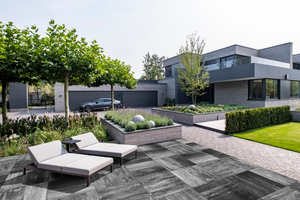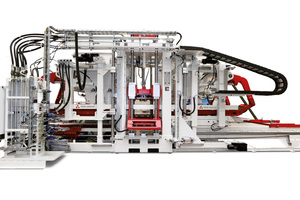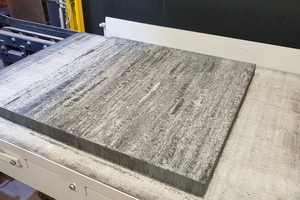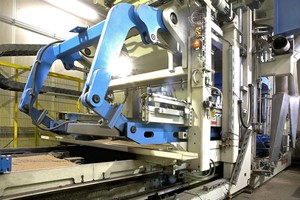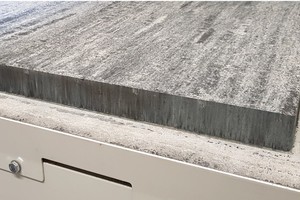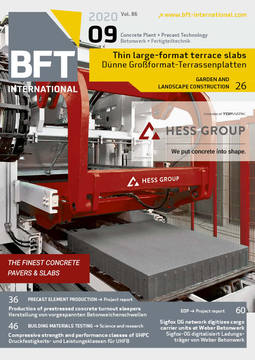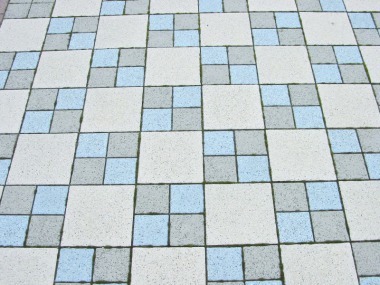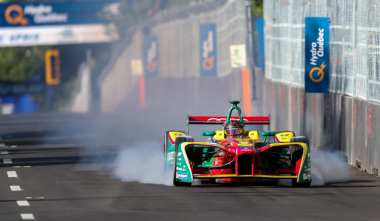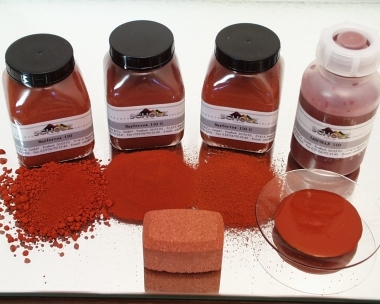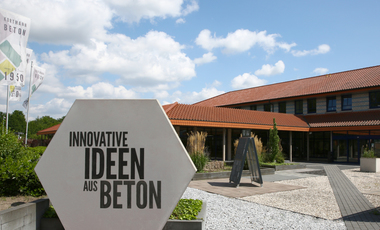Thin large-format terrace slabs from
Kortmann Beton
In recent years, Kortmann Beton GmbH & Co. KG has massively invested in new production technologies and has continuously and significantly broadened its product portfolio in design pavement. A large-format slab of 800 x 800 mm and only 50 mm thick is the latest development that, in collaboration with the process engineers of the Hess Group, is now in series production.
The company Kortmann Beton Group, based in Schüttorf near Osnabrück in the North German State of Lower Saxony, is a company with a long tradition. The family-run company was founded in 1950 and is now headed by Henning Kortmann in the third generation. The Kortmann range of concrete products for use in garden and home extends from terrace slabs and design pavement to garden construction.
The company, following a change of generations, has in recent years massively invested in new products and production technologies and, with new technical possibilities has continuously extended its product portfolio in design pavement. The latest product is the thin 800 x 800 mm format slab with mini-chamfer and a thickness of only 50 mm, which in collaboration with the process engineers of the Hess Group is now in series production.
New concrete block machine from Hess
Large-format, low-height slabs of uniform quality and density requires first of all cutting-edge machine technology, concrete of especially high quality and homogeneity as well as special knowledge of process engineering.
About one-and-a-half years ago, the Kortmann Company exchanged its block machine for a fully equipped RH 1500-3 MVA from Hess with high-end MAC-8 control technology. This machine engineering is the basis for the extremely demanding production of the new, thin large-format slab.
Maximum demands placed on new terrace slabs
Even manufacturers that produce slabs rather than concrete blocks rarely do so with such large format and thinness. Slabs of that size (800 x 800 mm) have a height of at least 60 mm or 80 mm. Achieving a uniform quality with very low height represents a real challenge. But Kortmann, nevertheless, pursues this ambitious project and, in its development, has also searched for support of process engineers from the Hess Group. The expectations were high: the height of the new slabs was required to lie reliably at ± 1 mm, with the facing at 6 to 8 mm and the density at least 2.4 kg/dm³.
And because Kortmann also aimed for a high-quality color mix with a sharply defined play of color and high color intensity, the colors used were not allowed to excessively intermix during production. To achieve a closed surface and, ultimately, terrace slabs with “barefoot feeling,” the water-cement ratio should be as high as possible. The slabs should moreover feature fine mini-chamfers, and the highest requirements were also placed on the quality of the surface:
The surface was to have a very fine/elegant structure;
The optic of the color mix should be true-to-nature;
The various colors were not to intermix to one color, as is mostly the case with conventional filler boxes;
The facemix used in production should be as moist as possible to achieve strong high-contrast colors and a closed, uniform surface.
Kortmann and the process engineers from Hess thus faced a major challenge.
Required machine engineering
The production of extraordinary slabs requires the use of just as innovative technology. The first task consisted of uniformly filling this large-area form. For this requirement, the high-performance MAC-8 control system of the Hess machine offers optimal basic prerequisites: the movements of the backing-concrete and facemix drawers as well as the tamper head are controlled with particularly high precision and with absolute repeat accuracy in every production cycle. Filler boxes are filled precisely via laser control. Additional guide plates were installed both in the backing-concrete and in the facemix filler box. Because the forms take up only part of the production area, the filler box was also adjusted accordingly. All of this ensures an optimal flow of materials in filling the form and preventing desegregation.
In addition to installation of the guide plates, the speed of the filler box was also optimized. The box must travel slowly enough to ensure the desired play of color of the end product and fast enough to ensure good cycling. Here, the patented Hess filler box-planing roller has a key role: with the Hess filler box, the concrete is not pulled out of the form, not even with very moist facemix. The planing roller ensures perfectly level filling of the entire slab without requiring reversing of the filler box. Another advantage of the planing roller is apparent on colored surfaces: because the surface of the concrete during reversal of the facemix filler box is not pulled back and intermixed, the coloring with the clearly defined play of color is maintained across the entire surface.
Kortmann is very satisfied with the performance of the H 1500-3 MVA, also for the production of this demanding product. Currently, around 1,500 terrace slabs are manufactured with color mix in 8 hours, with a very low reject rate of less than 3 %.
In addition, Kortmann manufactures standard pavers with the RH 1500-3 MVA with a cycle time of 12 sec.
Flawless mini chamfers and uniform density
When producing patio slabs of such large format with fine chamfers, it is not only important that the concrete be filled uniformly and precisely: the tamper head must likewise dip into the form with the utmost of precision. This is because even minor deformations, which are not yet visible during production, become clearly apparent to the customer during daytime. Here, the Feature Headguide from Kobra brings the best results since it ensures centering of the upper part of the form above the lower part, guaranteeing absolute precise submersion of the tamper head. Wear is reduced in that there is virtually no metallic abrasion on the form.
Ideal formula and Hess Variotronic oil bath vibration
How does adjustment of the vibration take place in the production of thin slabs such as these, so as to achieve uniform density? The answer is anything but easy, since conventional preliminary vibration carries the danger of excessively filling the form. Eliminating any preliminary vibration, however, results in fluctuating product heights. The solution for the slabs from Kortmann: the adjustable Hess Variotronic oil bath vibration. With it, amplitude and frequency can be adjusted separately from each other and optimally adjusted to the product. This not only results in excellent density, but consistently so – also in the middle of the slab. A Qavertec raw density-measuring device was installed directly on the production line, and the products randomly are tested for their quality following the vibration process. The result exceeded the specifications of up to 2.43 kg/dm³, which are generally only rarely achieved. The average density now lies regularly and constantly at 2.40 kg/dm³.
Finally, Hess process engineers had made recommendations for the formula: e.g., which grading curve had to be worked on to keep the packing density as high as possible. The water-cement ratio was set as high as possible to obtain a closed, fine surface. At a w/c ratio of 0.37, the w/c ratio is high compared to the standard. This gives the slabs a very long service life and makes them highly resistant to the action of frost and de-icing salt. The products from Kortmann are known to consistently undergo less scaling than specified by the Euronorm. The new, large-format terrace slabs ideally fit into the ranks of the Kortmann high-quality product portfolio. For the final touch, the slabs are coated with glass. This has the advantage, that the colors remain vibrant longer, thus ensuring the quality for many years.
New market segment with the same machine
Large-format terrace slabs with fine mini-chamfers, color mix with a sharply defined play of color and uniform density – the process engineers from Hess met all of Kortmann’s requirements so that the company is now able to cater to an additional profitable market segment. The Kortmann team was trained by Hess and, with the acquired knowledge, now enables Kortmann to manufacture the slabs optimally and to ensure a minimum reject rate.
The new terrace slabs meet the high expectations of demanding customers who prefer an open, modern style and expect elegant surfaces. Kortmann and Hess are pleased about their joint success and look forward to further collaboration.

